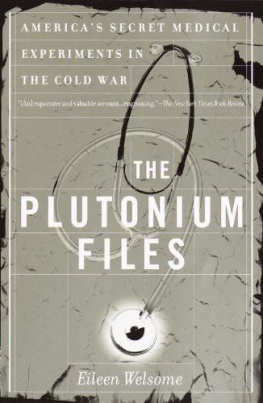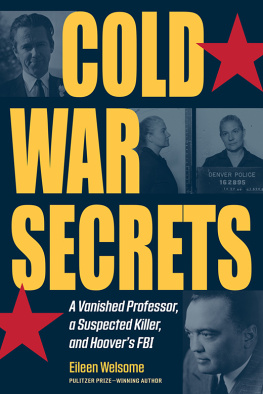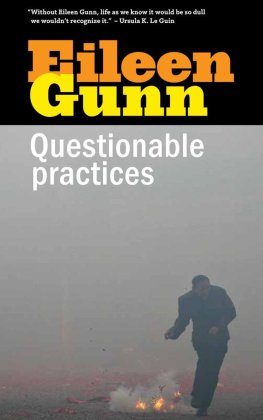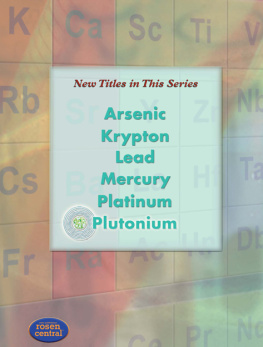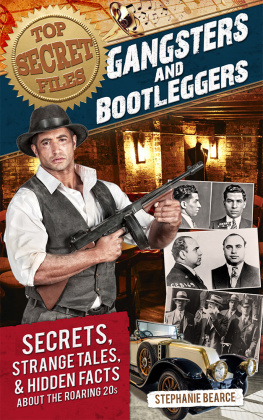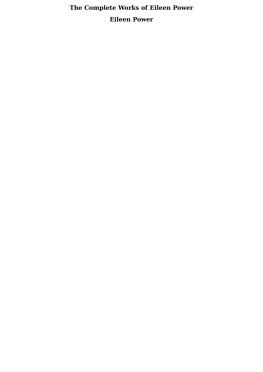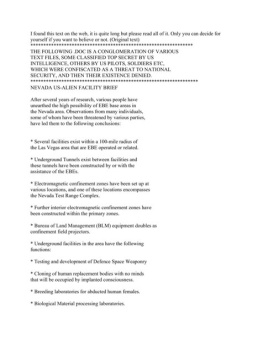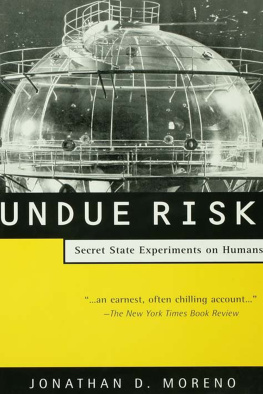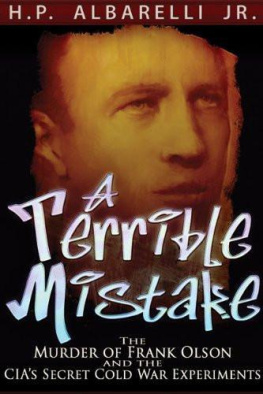Eileen Welsome - The Plutonium Files: Americas Secret Medical Experiments in the Cold War
Here you can read online Eileen Welsome - The Plutonium Files: Americas Secret Medical Experiments in the Cold War full text of the book (entire story) in english for free. Download pdf and epub, get meaning, cover and reviews about this ebook. year: 2010, publisher: Dell Publishing, genre: Politics. Description of the work, (preface) as well as reviews are available. Best literature library LitArk.com created for fans of good reading and offers a wide selection of genres:
Romance novel
Science fiction
Adventure
Detective
Science
History
Home and family
Prose
Art
Politics
Computer
Non-fiction
Religion
Business
Children
Humor
Choose a favorite category and find really read worthwhile books. Enjoy immersion in the world of imagination, feel the emotions of the characters or learn something new for yourself, make an fascinating discovery.
- Book:The Plutonium Files: Americas Secret Medical Experiments in the Cold War
- Author:
- Publisher:Dell Publishing
- Genre:
- Year:2010
- Rating:5 / 5
- Favourites:Add to favourites
- Your mark:
- 100
- 1
- 2
- 3
- 4
- 5
The Plutonium Files: Americas Secret Medical Experiments in the Cold War: summary, description and annotation
We offer to read an annotation, description, summary or preface (depends on what the author of the book "The Plutonium Files: Americas Secret Medical Experiments in the Cold War" wrote himself). If you haven't found the necessary information about the book — write in the comments, we will try to find it.
Eileen Welsome: author's other books
Who wrote The Plutonium Files: Americas Secret Medical Experiments in the Cold War? Find out the surname, the name of the author of the book and a list of all author's works by series.
The Plutonium Files: Americas Secret Medical Experiments in the Cold War — read online for free the complete book (whole text) full work
Below is the text of the book, divided by pages. System saving the place of the last page read, allows you to conveniently read the book "The Plutonium Files: Americas Secret Medical Experiments in the Cold War" online for free, without having to search again every time where you left off. Put a bookmark, and you can go to the page where you finished reading at any time.
Font size:
Interval:
Bookmark:
I am indebted to the many people who enabled me to write this book. It seemed that whenever I hit a rough spotwhether it was in the research, the writing, or the editing phasesomeone appeared and extended a helping hand. In particular, I want to thank the relatives of the deceased people who were unwittingly used in these experiments, as well as those subjects who are still living, who so generously gave of their time, recounting painful moments in their lives and providing me with invaluable documents and photographs.
One of the people whom I will never be able to repay is William Jay Brady, who became my unofficial scientific advisor for the project. Having worked at the Nevada Test Site since 1952, Jay not only possesses a firsthand knowledge of many of the events and scientists described in this book but also has a brilliant scientific mind and an almost photographic memory. He read the manuscript twice and spent many hours tutoring me in physics, mathematics, and radiation biology. Other scientists who helped were Bill Bartlett, John Gofman, Darrell Fisher, George Voelz, William Moss, Roland Finston, John Cobb, and Arthur Upton.
My heartfelt thanks also go to Mary Diecker, an indefatigable researcher who appeared at my house week after week with her arms laden with books and scientific reports. Many of the extraordinary details described in this book were uncovered by Mary during her many trips to the library. I also received research assistance from Albert Lukban, Lily Wound, Lorlei Metke, and Richard Halsey.
Countless government officials went out of their way to help me. Among the most helpful were employees in the Department of Energy, the very agency that had been so uncooperative when I began this project twelve years ago. I owe a very large thank-you to the DOEs Lori Azim, a lovely and efficient young woman who sent me dozens of documents. I also am grateful to Martha DeMarre, Jeff Gordon, and former staffer Cynthia Ashley at the DOEs Coordination and Information Center in Las Vegas, Nevada, for the rapidity with which they responded to my requests for documents. Evie Self, a declassification official at DOE headquarters in Washington, D.C., worked a minor miracle when she managed to get the accident report of Jimmy Robinson declassified by both the Department of Energy and the Department of Defense. The report had languished in Washington for more than two years and was in danger of being lost until she stepped in. Other government employees who helped were Diana Joy Leute, Ellyn Weiss, Bob Alvarez, Jim Solit, Rick Ray, Pam Bonee, Cheri Abdelnour, and Col. Claud Bailey.
Staffers from President Clintons Advisory Committee on Human Radiation Experiments were of tremendous assistance. In particular, I want to thank Dan Guttman, the committees executive director, with whom I had many lively discussions. Dan literally opened the committees doors to me, allowing me to copy hundreds of documents before they were boxed up and shipped to the National Archives. Lanny Keller, Trad Hughes, Gil Whittemore, Patrick Fitzgerald, Gregg Herken, James David, Patricia Perentesis, Jon Harkness, Kristin Crotty, Stephen Klaidman, Gary Stern, Gail Javitt, and Ronald Neuman were also helpful.
Loretta Garrison, formerly an attorney with the Baker & Hostetler law firm, was instrumental in getting many important documents on the plutonium experiment released under the Freedom of Information Act. Loretta and her husband, David, also opened their home to me on my many research trips to Washington, putting me up in their spare bedroom and supplying me with maps, subway passes, and umbrellas as I negotiated my way through Washingtons archives and reading rooms. James Houpt, another attorney with the Baker & Hostetler firm, helped keep my original notes and documents on the Cecil Kelley case from being subpoenaed by Los Alamos.
Many records used in this book came from the private collections of individuals. One of the most generous was Harold Bibeau, a subject in Carl Hellers testicular irradiation experiment, who sent me the bulk of the documents used in the chapter on the prisoner experiments. Other people who opened their personal files included Pat Broudy, Stewart Udall, Katie Kelley, Jackie Kittrell, Doris Baker, Martha Stephens, Sandra Marlow, Peter J. Thompson, Venlo Wolfsohn, Langdon Harrison, and Ubaldo Arizmendi.
Doe West, who chaired the Massachusetts task force that investigated the radiation experiments at the Fernald state school, spent hours tracking down photographs for me. I also received help from numerous professional archivists and librarians, including Margaret Moseley, a librarian in Newport News; Loretta Hefner, formerly with Lawrence Berkeley Laboratory; Roger Mead, the archivist at Los Alamos; Terry Fehner, a historian at DOE headquarters in Germantown, Maryland; Sandy Smith, at the National Archives; and Valerie Komor, at the Rockefeller Archive Center.
Scott Ware, the editor of the Albuquerque Tribune, gave me permission to use many of the documents and photographs from the original series. Colleagues Dennis Domrzalski, Ed Asher, Dan Vukelich, and Bob Benz were a great help, as were reporters in other cities, including Cory-don Ireland, Tim Bonfield, Karen Dorn Steele, Mary Manning, and Keith Rogers. Countless other individuals provided assistance, including Ray Poore, Oscar Rosen, Robert Campbell, Don Arbitblit, William Burleson, R. Joseph Parker, E. Cooper Brown, Thomas Fisher, David Egilman, Cliff Honicker, Kitty Alvarez, John Abbotts, James P. Cooney Jr., Meta Heller, John Daniel, Madonna Daniel, Don Byers, James Brascoe, Jeff Petroculley, Ray Heslin, and David Hilgemann.
I am also indebted also to Jim Bettinger, the deputy director of the John S. Knight Fellowship Program at Stanford University, who took time out of his busy schedule to plow throught the first draft of my manuscript, offering many intelligent suggestions for the revisions and much-needed encouragement. Luis Tovar and Diane Edwards also read the first draft, gently pointing out the rough spots that needed to be smoothed.
I cannot begin to express my thanks to my dear friend, Loydean Thomas, who listened patiently to my ordeals over the years. I also owe a special thanks to my next-door neighbor, Dena Daniel, now eighty-four, who cruised the airwaves, capturing on tape anything that might be related to the project and leaving it on my doorstep each evening.
I am also indebted to my literary agent, Lisa Bankoff, for her unwavering support, as well as to the people at The Dial Press who saw this book through to publication. I have an abiding gratitude to my two wonderful editors, Beth Rashbaum and Susan Kamil. With a ruthless pen and gentle heart, Beth took a grocery bags worth of manuscript pages and turned them into this book. Susan guided the project through all its twists and turns. Her commitment was constant, her enthusiasm unflagging, her advice inspiring. I also want to thank Zoe Rice, for her incalculable assistance and unfailing courtesy; Random Houses Bill Adams, for his superb legal review; Virginia Norey, Brian Mulligan, and Roberto de Vicq de Cumptich, who worked on everything from the jacket to the interior design of the book; Susan Schwartz, publishing manager, and Johanna Tani, chief copy editor, who shepherded the book through the production process; and copy editor Debra Manette, who culled out more errors than I believed were possible. Those that remain are my own.
And finally to my husband, Jim, I owe my deepest gratitude. He has always believed in this book. More than anything else, it was his love and confidence that carried me through the years. He read the manuscript at least four times, offered many invaluable suggestions, and endured years of endless discussion about the people and events described here. It is not an exaggeration to say that without Jim, I might not have completed the journey.
Font size:
Interval:
Bookmark:
Similar books «The Plutonium Files: Americas Secret Medical Experiments in the Cold War»
Look at similar books to The Plutonium Files: Americas Secret Medical Experiments in the Cold War. We have selected literature similar in name and meaning in the hope of providing readers with more options to find new, interesting, not yet read works.
Discussion, reviews of the book The Plutonium Files: Americas Secret Medical Experiments in the Cold War and just readers' own opinions. Leave your comments, write what you think about the work, its meaning or the main characters. Specify what exactly you liked and what you didn't like, and why you think so.

